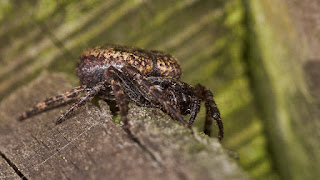Ifton Meadows Nature Reserve, Wednesday 19th September 2018
To
quote the description on the 'Shropshire's Great Outdoors' website: “Ifton
Meadows Local Nature Reserve is a former Colliery site which has since been
re-clothed by nature to provide a diverse mosaic of habitats and notable
species. From semi-natural ancient woodland with extensive swathes of British
bluebell to skylarks nesting on the acid grassland with views across the wider
countryside to the Welsh hills.” The reference to distant views might suggest
to the reader that the site is a little exposed. And indeed it is. A most
interesting place, but we chose to visit on a day marked by very strong winds.
Nice in the sunshine, we nevertheless had to shout at each other to be heard.
Before long, a decision had been made to retreat into the woodland on the lower
slopes of the site in search of shelter.
Before
we took to the trees, the grassland was swept, and a few recently planted oak
saplings beaten. A caterpillar was spotted, sunning itself in the grass. This
turned out to be the larva of the speckled wood butterfly.
 |
| Photograph: David Williams |
Later in the day we
saw two adults flying in the trees, demonstrating the continuously brooded
nature of this species. Three earwigs also appeared in quick succession, two
from the grassland, one from the plantation. These were not the ubiquitous
common earwig however, but its much less often seen cousin Lesne's earwig, Forficula
lesnei.
 |
| Photopgraph: David Williams |
This species has now turned up at half a dozen sites in VC40, all
of which have one thing in common: landscaping work which includes tree
planting. The insect is usually discovered in the plantations themselves, and
this was the case again here. Somewhere there is a tree nursery which is
seeding Shropshire with this unobtrusive insect. Ifton Meadows is the most
northerly Shropshire location yet, and I believe the most northern inland
record in Britain. One of our group collected a couple of ichneumon wasps for
later identification. Ichneumons are a large & difficult group & seldom
(if ever!) feature in our species lists. So to claim these two records for the
day was particularly pleasing.
 |
| Acrotomus succinctus - Photograph: Bryan Formstone |
 |
| Dyspetes praerogator - Photograph: Bryan Formstone |
In
the woodland, we were at least able to communicate without shouting, though the
roar of the wind in the tree-tops was a little alarming. The weather also now
decided to become cloudier, and was soon depositing rain at an angle nearer the
horizontal than vertical. Fortunately this soon passed, and the day improved
steadily from there, though the wind if anything increased in strength. The
bark of a large tree-stump was peeled back, and revealed two cells formed in
the underlying detritus. One contained a large ground beetle; the other a
hibernating bumblebee, probably the tree bumblebee, Bombus hypnorum. Clearly very drowsy, we snapped a couple of
quick pictures & carefully replaced the bark over it.
 |
| Photopgraph: David Williams |
We
reached the edge of the woodland and heroically decided to brave the maelstrom.
Beating oaks at the woodland edge produced hawthorn and bronze shieldbugs,
 |
| Photopgraph: David William |
 |
| Photopgraph: David William |
and
the larva of the micromoth Diurnea fagella, all from oak. This last
creature is distinguished from all but its two closest relatives by the
modified third pair of thoracic legs, which have developed fleshy 'boxing
gloves'. The colour of its head capsule clinches the species identification.
 |
| Photopgraph: David Williams |
Continuing
along the woodland edge, a birch shieldbug was spotted on white poplar. Clearly
a day for finding shieldbugs on the 'wrong' plants – perhaps they had been
blown there by the wind!
 |
| Photopgraph: David Williams |
By now the sun
was shining brightly. But the wind finally wore down our resistance, and we
headed back to our cars and the prospect of a journey home along roads littered
with twigs and branches.
 |
| Photograph: Nigel Cane-Honeysett |





















































































